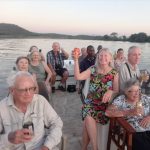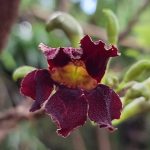TREE LIFE 521
JANUARY 2024
FUTURE EVENTS
Saturday 6th January 2024:- visit to the National Botanical Gardens. Meet at 8.30 in the main car park.
Sunday 21st January 2024:- We plan to visit the Lake Chivero Arboretum. This was planted on Signal Hill in the 1950s and the last Tree Society visit was in September 2022. It is now time to see what changes the rain has made. After botanising we eat, drink and socialize so don’t forget your folding chairs and refreshments.
Directions: The Lake Chivero turnoff is on the left just past the Manyame Bridge on the Bulawayo Road. Follow the road as if you were going to the Lake Chivero Game Park. Once over the hill, there is a turning to the left at the bottom of the hill – it is signposted.
February outings: details to follow via WhatsApp and your next Tree Life.
As it is in theory the rainy season, please check your email or WhatsApp for updates in the morning as outings may be postponed due to “inclement weather”.
TREE LIFE
KANYEMBA SPECIAL
EDITOR’S COMMENTS
This issue of Tree Life includes a special edition showcasing the many contributions received by members about the Kanyemba trip. I wrote a summary on the expedition from a non-botanical point of view for Tree Life number 520. Below is the outline of the scheduled days’ activities followed by member contributions.
DAY 1: Travel to Kanyemba and Masau Lodge;
DAY 2: A day driving into the dry forest of the valley;
DAY 3: A trip upriver to Mupata Gorge.
DAY 4: A further river trip to the Red Cliffs past the day before on the way to Mupata Gorge;
DAY 5; Return travel to Harare.
PARTICIPANTS:
Anne Butler, Cathy Sharp, Di Drummond, Fiona Lawrance, Frances Morris, Ian Riddell, Jan van Bel, Jenny MacKay, John Lawrence, Karl van Laeren, Linda Hyde, Lorraine Gifford, Mark Hyde, Meg Coates Palgrave, Mundoga Kambazvi, Peter Morris, Rob Jarvis, Ryan Truscott, Sheila Jarvis, Sikhumbudzo (Nyathi) Mulunjana, Vic Gifford, William Clarke, Zia Thomas.
Our thanks to Ian, Nyathi and Mundoga who accompanied us as licensed hunters.
DAY 1: TRAVEL TO KANYEMBA AND MASAU LODGE
TRAVEL WITH ‘BLONDIE’: BY ZIA THOMAS
During winter this year I was in Cape Town, the weather was miserable, and I was tired of walking in the rain and wind and I just wanted to go home. Then I read the Tree Society was visiting Kanyemba in the Middle Zambezi in November. Heat at last, Yay!
According to my Dad, I’d last been to Kanyemba with him and my brothers 57 years ago! I knew I wanted to be on that trip! Fortunately, there was space for me, and I was on my way.

“Blondie” & Co.
Excited was an understatement!
Vic, Lorraine and Jan travelled with me in ‘Blondie’, my trusty adventure Buddy since 1994. She’s a big girl with flowers in her hair and she’s always available to head out for some fun! I’d heard repeatedly over the years that the road to Kanyemba was awful but knowing my Blondie I was not worried, she’s a big strong girl just like me and can handle almost anything!
We arranged to travel in convoy with Frances, Peter and Cathy whom we met at Mazowe Dam. By 7.15 the others had arrived and after a quick look at the dam, which was pretty full and looking lovely, we left around 7.30 and drove towards Mvurwi.
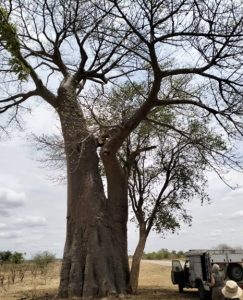
The highest Baobab in Zimbabwe
An hour or so later on with fairly ok roads, we stopped in Guruve. Some needed to fill up with fuel and for those of us who needed a loo stop the available facility was clean and actually had water!
Back on the road, we came across Karl on the side of the road looking at the “Highest Baobab in Zimbabwe.” This impressive tree had a beehive nestled halfway up in a protected overhang near the fork. The locals had hammered wooden pegs into the bough halfway up to fashion a ladder for easier access to the delicious honey up there. Soon after admiring the beehive, Rob Jarvis and Bill Clarke caught up with us and our group was complete.
It wasn’t long and Rob zoomed off again in front of us in true Mountain Club Style!
Within 15km of leaving the Baobab, the altitude changed pretty drastically! What a fun and such a pretty winding road we found ourselves on with sharp bends and curves. And the views went on forever over the Zambezi Valley.
It is so stunning and as the scenery and warmth permeated my entire being, I began to relax and actually feel like I was on holiday!
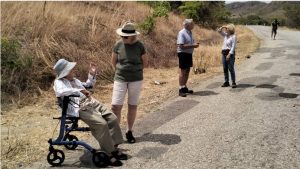
Botanising with Meg on the escarpment
A word that I was not at all familiar with but that was bandied about a LOT was ‘botanise’! Now I get it, after all I am a member of the Tree Society! Looking at and collecting bits of trees and other plants ~ then talking about, deciphering, distinguishing, and recording what we’ve seen, when, where etc. Then Cathy climbed onto the back of her truck and hauled out ‘the press’ and the meaning of ‘botanise’ was now complete!
Our first use of this word began when we made an impromptu stop on the steep escarpment road at a lay-by. We stopped to admire a Brachystegia allenii. This name and this tree was the first ever to reach my conscious awareness! It has lovely mid-green leaves that overlap and look a bit like a Venetian Blind. For someone who is totally green behind the ears and barely knows the difference between a Msasa and a Mnondo, this description made perfect sense and I hope I never forget it!
Thereafter, we dropped down, down, down into the Zambezi Valley, and fortunately for us the weather was overcast and it was very pleasantly cool but not too cool, even in the Valley.
National Monuments Beacon heralding a petrified forest
The last possible stop for fuel was at Mahuwi, a dusty little village where, soon after leaving the business area, the tar ended. I thought the road, which continued to Mushumbi Pools, wasn’t too bad. After we crossed the Manyame River we headed west for a bit and then north. Within 20 km of Mushumbi Pools, we came to the National Monuments beacon heralding a Petrified Forest. I had read an article that claimed this forest is older than history itself. Apparently, these trees were coniferous, the climate being temperate back then ~ approximately 100 – 200 million years ago. How life changes.
At this stage of our journey, the road surface changed and became a little less comfortable. I knew we had 3 more rivers to cross to get to the Zambezi and was still looking forward to the drive. The Dande, Kadzi and Angwa rivers all drain from the escarpment and still lay ahead…
As we progressed, the road became way more corrugated and the whoop-de-do’s were epic! We stopped on the Angwa Bridge and admired the soft sandstone below with potholes the lovely whirl in the side being created by a stone being whizzed around as water rushed downstream during the rainy season. We heard an Eastern Nicator but never got sight of it. What we did see were Carmine and white-fronted Bee-eaters. Such beauty and melodic resonance emanate from these tiny creatures. I think birds are so lucky, they get to fly, their plumage is often beautiful and they can sing such sweetness bringing joy to the hearts of anyone who will stop to absorb all that they are!
After a little while, we stopped again at the Kadzi River. Here we climbed down, under the bridge and walked about a hundred metres along the dry sand riverbed to check out the ancient Peat Pit which is no longer a pit! Today, it is about a metre and a half above the riverbed.
The Peat Pit is clearly visible from a short distance with its layers of inky blackness and feathery edges. Taking a small piece, the layers of biomass were compressed together and had the feel of a Rizla (fine cigarette paper) and looked like very thin charcoal-coloured crepe paper. We could even distinguish ancient leaves within the layers. So awesome to think these layers had been compressed so many millions of years before and also a clear illustration of how coal has been made.
Along the way, we were halted by a band of 4 Southern Hornbills sauntering along the road. They were not at all concerned about us until we started up our engines, then they waddled off, surprisingly quickly into the bush at the side of the road. A little later on we came across another 4 of these endangered species. As soon as they heard and saw us, they actually took off quickly and flew off into the bush. They are surprisingly graceful in flight and a sight to behold as they lift their glossy black, heavy bodies up into the air!
From here, it took us another 2.5 hours to reach our destination. By that time we had been travelling for 10 hours instead of the expected 7 hours! I was tired and extremely grateful to finally reach the end of that grizzly, bone-jarring, teeth-rattling road!
A SLOW WAY DOWN: BY KARL VAN LAEREN
On the right-hand side of the road, about 1.3 km after the grid gate between Mvurwi and Guruve and after the store appropriately named Grid Store, stands a large baobab tree on a rocky base. This is at an altitude of 1353m. and it was fitting that I should stop and visit this tree as the first botanical obligation especially as it was to turn out that Chief Mutota’s Baobab on the valley floor was going to be my last point of call before leaving the Middle Zambezi Valley (MZV) via the Alpha trail to Centenary. This tree is to be respected and appreciated as our sacred rite of passage for us all that needed prior appeasement to grant us a successful adventure. And how generous the rewards were going to be!
The next botanical milestone for me at least is the large Ficus bussei on the left road verge in Guruve opposite the fuel station. This is another valley floor species that probably made its way here as a chance happening of the trade and travel route to the valley floor.
The Zambezi escarpment road meanders down to the Mahuwe fly gate which is still being managed by the Tsetse department. Both Ximenia species were in fruit, the smaller and more common and supposedly more sour fruit is that of X. americana species with smooth blue green leaves. Nobody should be allowed to pass their first tree in fruit without being given a ripe fruit to suck on! Like the baboons before me had been demonstrating one should spit out the skin. Rarely, one may find a moderately sweet Ximenia fruit which was my experience till eating the second fruit from the same tree! I believe that the oil extracted from the inner kernel has anti-aging properties but the outer sour fruit can age one in seconds so an effective antidote has merit indeed!
An especially exciting find was a few Adenia karibaensis (Cat o’nine tails, what a nice name as it reminds me too of cats!). One plant displayed both its striped fruit and bunches of flowers. As a vet, my mind always links the diagnostic pair of swollen glands at the base of the petiole and its palmate leaf to resemble a neat symmetrical pair of small cat testis!
Brachystegia allenii has to be a tree that gets everyone excited. It is an indicator that we are leaving the highveld into a rich new and exciting area. Its blue-green leaves set obliquely to the rachis and without a petiole is an easy giveaway. I enjoyed Coates Palgrave’s description of the leaf as “making them look as if they are louvred” to differentiate from B. manga which we may have encountered on our last day.
Another easy specimen to visit is on the circle in the parking lot at Marongora booking office. Seeing Bindura bamboo, Oxytenanthera abyssinica, reminded me that I was indeed in the Mavuradonha escarpment and of my very first botany excursion even in this country to try and find the Buchwa endemic bamboo, Oreobambos buchwaldii, which was feared to have become extinct due to the mining activities We failed to find any but I think subsequently it has been found there.
Olax obtusifolia or large-fruited Olax grew in the stormwater drain as did a Stereospermum kunthianum. Some of you may remember the fine pink jacaranda specimen that grew in the last lay-by on the way down the escarpment before turning off to Mana Pools. Our Hunter-Guide, Nyathi indicated that this tree was a favourite browse tree for eland. In Kanyemba I was to encounter its more widespread cousin Olax dissitiflora or small fruited Olax. Both have deep green leathery leaves folded inwards along the midrib. Fruit turning ripe was already in evidence. The light grey smooth bark covered what appeared to be very hard and dense wood and resembled Boscia albitrunca bark.
Pouzolzia mixta also grew on the roadside and again Nyathi enlightened me about his childhood memories related to this species. By pounding the roots, a thick slimy soapy goo could be made that made for a good kids’ slide if applied to a smooth surface. Nothing like getting personal stories from folk who used these trees firsthand.
Other finds were Terminalia stenostachya, Albizia versicolor, Ficus sycamorus, Bridelia cathartica. Purplewood, Dalbergia nitidula, with its characteristic galls was something Nyathi pointed out to me as a common finding on these trees. Enclosed is a picture of both the young and the mature galls.

Young and mature galls on Dalbergia nitidula
We were to see Dalbergia martinii a few days later which, with its wrap-around branchlets, was on the rocky hillside leading up to Matombo Camp overlooking the quite unique Mwanzamtanda floodplains.
The seven-hour journey to our destination took a marvellous 12 hours due to botanical detours and self-imposed natural history/ archaeological “roadblocks”. At my age, I may never get to see this area again so it is better not to rush through it too hastily as one would be the poorer for it.
DAY 2: A DAY DRIVING INTO THE DRY FOREST OF THE VALLEY
A PERFECT DAY FOR BOTANISING: BY JAN VAN BEL
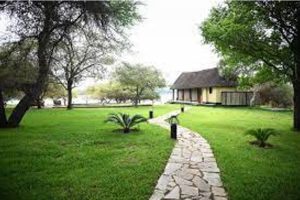
A perfect morning at Kanyemba
The 2nd day, our first morning waking up a few meters from the fast-flowing Zambezi river, was a cloudy day, exactly as the weather report had predicted. We had agreed at supper last night to take our time to commence this promising day. No rush to get everything done and seen before the midday heat and plenty of time to get rid of the last rattles of yesterday’s bumpy road. Cleansed by the smooth confident majestic river that pervades us, we regained our equilibrium and started becoming part of this perfect harmony of water, plants, trees, birds and animals.
By 8.00h the whole troupe was divided over 5 cars and on the road we went. The first plant name I recorded today as special was a Crinum, an amaryllis relative. There was enough hesitation as to naming the species, that I leave this to the specialists.

Amorphophallus abyssinicus subsp. unyikae
The next stop, just a few minutes later was probably initiated by Cathy with her incredibly sharp eyes for flowers, and who sees fungi and mushrooms where we only see tree bark. The dark-burgundy colour of the flower, not really contrasting with the surroundings, has been named as an Amorphophallus abyssinicus subsp. unyikae. Cathy was very excited about this find as it is a plant that only flowers every few years. Everyone left the car to have a closer look at this interesting flower.
It is from the same family as the much bigger Amorphophallus titanum, the corpse flower which is endemic to Sumatra. This plant attracts thousands of visitors at botanic gardens around the world when it is in flower (every 7 to 10 years), When in flower those botanical gardens are often open till late in the evening and on holidays. It is supposed to attract thousands of insects with its smell; however, our find didn’t have much of a scent.
The Dry Forest was next on the map. It is a deciduous forest with high trees and understory thickets. This location was not exactly a place you would expect a botanical troupe to be attracted by and do what they usually do. Here and there some small leaves were developing. Other trees had some dry fruits or pods still hanging. Even the dry leaves under the tree could sometimes give a clue or create more uncertainty.
The following is not a full record, but I recorded:
Monodora junodii, green-apple, easily identified by our guide Nyathi;
Pterocarpus lucens, small-leaved bloodwood, with a recognisable flaking bark;
Boscia mossambicensis, broad-leaved Boscia, distinguishable by its smooth leaves, while the B. angustifolia species has narrower leaves.
While we were trying to identify those silhouettes of trees, Cathy was busy discovering mushrooms. A big toadstool, she named Ganoderma, a pore fungus. Next was a Hexagonia, honeycomb fungus. It is a much smaller fungus and looking at its underside, you could mistakenly think it is a honeycomb.
One of the trees we had been looking out for, indigenous to this place was Xylia torreana, hairy Xylia, with its single pair of large composite leaflets, a bit unusual for a tree. Also Combretum kirkii, the large-fruited climbing combretum, a woody liana with knobbles along the stem. Alchornea laxiflora, lowveld bead-string, was a new name for me. It’s more like a shrub and has large leaves. It is another 3-veined leaf tree and easily identifiable by its two hair-like stipellae at the base of the leaf. Citropsis daweana, wild citrus, with compound leaves, winged rachis and armed with straight spines.
Our hunter-guide Nyathi then invited us to visit the last hunter camp that is still operational in this area after 5 others were closed for the season. As we were still hoping to see the Brachystegia manga, the blue-leaved Brachystegia. Nyathi knew of a tree that could possibly be the one we were so eagerly looking for. No conclusive identification could be done with the knowledge that hybrids in this genus exist and the close similarity with B. allenii and B. utilis. The camp had several planted trees, not indigenous to this area. We saw a mopane tree with a big epiphyte. A shrub with jasmine-like flowers was named Holarrhena pubescens, jasmine tree. Boscia albitrunca, shepherd’s tree, a small tree with stout white bark. Combretum species collinum, mossambicense and elaeagnoides were recorded several times. Mark must have recorded many more trees while I was just wondering what all these dry sticks would turn into.
On the way back to the lodge, we stopped the car in the middle of the road when two ground hornbills were gracefully walking away in front of us. A little further on we saw their nest high up in a big tree.
It had been a perfect day for botanising in an almost leafless forest. A cool breeze and the sun remained behind the clouds for the whole day. Frances and Peter had organised and planned it perfectly. They must have communicated with the weather gods.
We were back at our lodgings in time to have a rest or a dip in the plunge pool. By evening Mark and Meg were already organising and identifying their tree samples. Everyone had a good meal, not forgetting the delicious dessert. After that, we were divided into 4 groups for a fun quiz, set up by Bill. After a hundred questions, the quiz was interrupted for a break and to plan the next day. Slowly people started strolling to their beds while others still in need of socialising were enjoying the bar.
BOTANISING AWAY FROM THE RIVER JOHN LAWRENCE
Most of the party set off after breakfast for a morning of botanising from cars away from the river. It turned out to be a much longer day than expected.
Our first stop was on the flats near the villages to admire a small colony of Amorphophallus, a most unusual member of the Arum family with a single dark purple flower. We drove on to the “dry forest”, most aptly named as at first sight it consisted of nothing but a tangle of dry branches and trunks, but very exciting for the botanists. A few shrubs had leaves, and with the help of binoculars, it was possible to study leaves and even flowers on the crowns of large trees.
For the non-specialist, the most interesting finds were some fungi that Cathy was able to explain to us. A bracket fungus on a bare trunk had a fascinating honeycomb structure on its under surface, while feather-like white patterns on a wad of dry leaves proved to be the mycelia of developing spores.
After a few more stops we arrived at a hunting camp for refreshment and a rest from driving. Half the party opted for a return to base for lunch, but the diehards continued into miombo woodland in search of Brachystegia allenii and B. manga, species that only occur in the extreme north-east of Zimbabwe. We managed to find B. allenii, with its “venetian blind” leaflets, though it took some athleticism to collect good specimens, but B. manga eluded us.
Eventually, we gave up and set off back to base by a side road through riverine-type woodland that necessitated many stops to examine unusual species, some of which defied identification. At one point our driver asked what the odds were that we wouldn’t stop again. I said, “not good”, and indeed we stopped after another 200 metres! However, we didn’t begrudge the botanists, as it was a wonderful opportunity for them to see new species in their natural habitat. We eventually reached the lodge at 1730, far too late for lunch but in time for a very welcome cup of tea.
MORE PHOTOS: ROB JARVIS
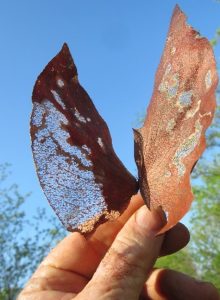
Filigree Mopane leaf
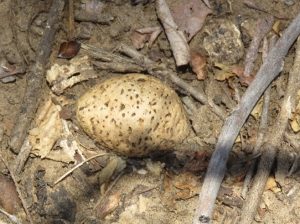
Mangongo nut in the dry forest floor on the Kalahari sands
EDITOR’S NOTE: Schinziophyton rautanenii: The mongongo, manketti or nongongo tree is valued for its seeds, fruits and timber. The fruit pulp is eaten raw or cooked and has a flavour similar to plums.
DAY 3: A TRIP UPRIVER TO MUPATA GORGE
ADVENTURES ON THE RIVER:
TEXT AND PHOTOS BY IAN RIDDELL
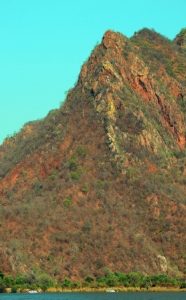
Lilliputian Pontoons pass through The Gate
The woodwind section started far too early with Mr & Mrs Pel’s hooting off stage. Then the main orchestra wound up with Rhapsody on a dawn chorus, and a splendid performance it was with Mr Collared Palm-thrush leading in the deep rosaceous glow in the east, bleeding it out to a bright yellow and a quiet finale. Being far too modest, our conductor and virtuoso left the stage with a bow to only the early birds!
Then it was coffee and breakfast time and gradually our “clowder” assembled for a quick repast before being herded aboard the boats by 7 a.m. and off we headed, bound for the Mupata Gorge. Our craft got a bit stuck on a sandbar and then we had to spend a short time dealing with Parks officials as the other boats dwindled into the blue.
NOTE: clowder: a collective term for a group of cats
Gradually we made our way upstream, noting Euphorbia cooperi and Garcinia livingstonei on the hillsides and many splendid Large-leaved Rock figs Ficus abutilifolia corseting and flowing down the cliffs. Interesting that this abundant fig isn’t shown in Coates Palgrave as occurring in this part of the valley!
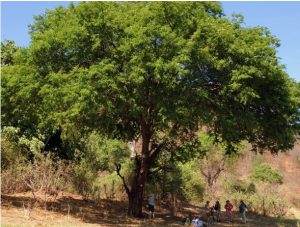
Acacia robusta clavigera

Euphorbia cooperi
About 24 km upriver we beached by an impressive, splendid Acacia, Acacia robusta subsp. clavigera, with a fine Sausage Tree Kigelia africana just behind it, and got to botanising.
Here we found Crocodile-bark ebony, Diospyros quiloensis; Spiny jackal-berry Diospyros senensis; Purple cluster-pear Cleistochlamys kirkii; Purple hook-berry Artabotrys brachypetalus with some fruit; Y-thorned Torchwood Balanites maughamii; Combretum obovatum flowering and fruiting; Wing Pod Xeroderris stuhlmannii and a few others.
A Flannel Weed Sida cordifolia was flowering by the river side but we were stumped by a pinnate-leaved tree up the hillside.

Bill’s tree – we need a full account, Bill!
Our clowder became a “declutter” as some of our cats splintered upstream with an armed escort despatched on their heels lest they meet some unexpected wildlife with big feet or sharp teeth. Above them on the ridge was a clustering of unidentified euphorbias. One of the trees they rested under looked like an African ebony Diospyros mespiliformis, a fairly common tree in the gorge. As we packed up the boats our wanders were prompted to return and we headed back downstream.
EDITOR’S NOTE: Three or more cats are a clowder but there are other names used for a group of cats, such as a clutter, a glaring, or a pounce, hence a declutter.

Croc waiting for “Man overboard”
I stopped our boat at a rugged and incised spur that was most intriguing and different to the other mountainsides. The river-polished boulders were steep and slippery as we gingerly edged in for a tenuous mooring, supervised by an interested crocodile who wouldn’t have said no to a “man overboard!”.
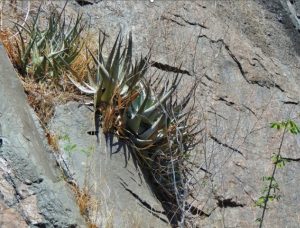
Unidentified aloes
Trees and vegetation commingled along the spines of the ridges bisecting the spur looked like a giant had cleaved into vertebrae with a great axe.
Down at our level unidentified aloes and grasses thrust their roots into every crack that gathered soil, proving that “life finds a way”. Long vertical indentations in the rock looked like it had been moulded with great pipes or poles pressed halfway into its surface, a most intriguing geology.
In flatter spots with more soil were many unidentified and mostly leafless trees but we didn’t have the time to collect samples and navigating the treacherous cliff was another matter, as my bloody shin affirmed. I looked down to see if the croc was hanging around, awaiting a slip-up (or slip-off!).
We continued to flatter terrain just downstream of the Tunsa river mouth, where we moored under the shade of overhanging trees for our picnic lunch; a Yellow-billed Kite perched in the boughs of a rain tree above us, eagerly awaiting any scraps.
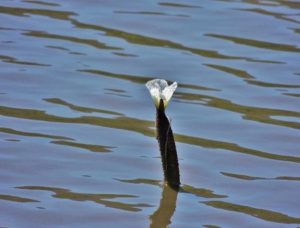
Ottelia muricata
Some of the group had headed inland whilst I was photographing a White Water-pistol Ottelia muricata.

Limnobium evigatum or Amazon Frogbit
Later, as we left the spot, a clump of Amazon Frogbit, Limnobium laevigatum, was caught up at the back of the boat. This native of Central and South America, classified by the California Department of Food and Agriculture as a Noxious Weed, was new to Zimbabwe in 2005 when found at Lake Chivero and has spread to Bulawayo, Kariba and the lower Zambezi Valley (See the Flora of Zimbabwe site).
I found it covering most of Skull Pan at Mana Pools National Park in 2018 and I also saw it at Chirundu in 2022. Since clumps were merrily bobbing their way down the river as we returned to the Lodge, it has undoubtedly colonised Cabora Bassa and must eventually get past the dam wall and onward to the sea.
Our boat conked out a few kilometres from our destination and we drifted down on some hippos while waiting for the others to appear and rescue us, ending our trip in quiet indulgence at the end of a tow rope.
DAY 4: A FURTHER RIVER TRIP TO THE RED CLIFFS
EDITOR’S NOTE: AMENDED PLANS
Some of the party were keen to spend more time around the Lodge while some were still keen to go upriver. Others were simply exhausted and keen to have a lazy day. Further ideas were to visit Kanyemba itself as well as the salt pans between the Lodge and Kanyemba and to finish the day with sundowners before packing to go home. Here are the individual notes:
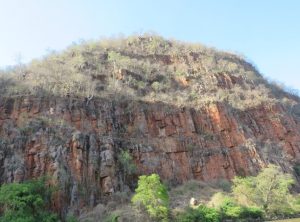
The elusive red cliffs
THE RED CLIFFS: BY ROB JARVIS
I had hoped to climb to the top of the Red Cliffs, just upstream from our Lodge at Masau on the Zambezi. But when travelling past by boat it was clear that landing at the base of the cliffs was very difficult and a way to the top even more problematic. When on a fishing trip about a decade ago I was intrigued by the apparent man-sized, bonsai-like forms of various trees clinging to the cliff. Clearly visible were grey baobabs, white and pink-barked Sterculias, green-stemmed Commiphora, some lianas, like Fockea and many others, especially Ficus species. There is no doubt that I shall have to go back to Kanyemba and walk up the ridges behind the cliff and see if the botanical life can be accessed more easily from there.
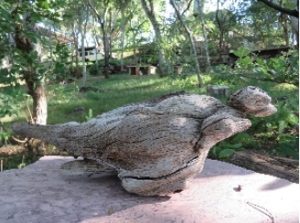
The driftwood duck
Whilst on that particular fishing trip I collected a very duck-like piece of driftwood on one of the sandbanks where we chanced our luck for tigerfish. We still have the natural sculpture, still very duck-like and not damaged in any way after being exposed to Harare’s elements every year since 2012. Hard wood indeed.
EXPLORING AROUND THE CAMP: MARK HYDE
A small group of three, Cathy, Ian (with a weapon) and I decided to explore the alluvial riverine forest in and adjacent to the Lodges.
The riverine area had a flora broadly similar to Mana Pools, with enormous Faidherbia albida, Philenoptera violacea and Kigelia africana. Also Combretum microphyllum which must look spectacular when in flower. Cathy pointed out the more unusual var. sieberiana of Acacia sieberiana. This has more yellow bark than the more normal var. woodii we generally see around Harare. To complete the similarity with Mana, there were also some pools with an interesting fringe of aquatic plants.
This generally shady, lush and often muddy environment was totally different to our earlier explorations and naturally had a very dissimilar flora.
In general the riverine was in good condition with few exotic species, although we did see a bit of Lantana and Tithonia rotundifolia (Mexican marigold) but around the lodges there was a greater influence of man in either accidentally or deliberately introducing species. Of which more later.
Much of the interest here lies in the herbaceous flora which is somewhat out of the Tree Society’s area, but a complete list will be available. An attractive, yellow-flowered delicate climbing Cucurbitaceae close to the Lodges turned out to be Momordica charantia. Ian Riddell found and identified a small highly sticky purple herb called Brillantaisia pubescens which was new to me.
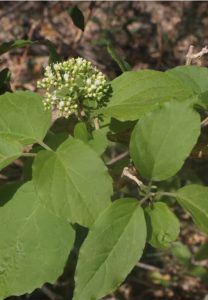
Premna senensis
Of interest was a shrubby Pavetta with very immature leaves which turned out to be Pavetta cataractarum, the Zambezi bride’s-bush, A somewhat unusual shrub in white flower was Premna senensis, the Large-leaved skunk-bush. The leaves smell unpleasant when crushed, hence the reference to a skunk.
Frequently seen were the spiny scrambling stems of Maclura africana, the African osage-orange. Two species of Jasmine came up for discussion amongst the group. The first was a white-flowered Jasminum climbing amongst shrubs near the camp. This species had 3-foliolate leaves and black berries and was J. fluminense, which from the Latin means ‘of rivers’, an excellent name well describing its habitat. A second species of shrubby Jasminum seen in the dry woodland sometimes in spectacular massed flowering was J. stenolobum, which has simple leaves and larger flowers.

Pluchea dioscoridis
Also much-debated was a scrambling semi-woody shrub with purplish flowers; this turned out to be Pluchea dioscoridis as was suggested at the time.
As I mentioned before, around the lodges you also have the influence of man. Indeed the name Masau refers to the thickets of Ziziphus mauritiana which appear to have become well naturalised and self-perpetuating in the area.
A number of indigenous trees had been planted, namely Cordyla africana, Oncoba spinosa, Khaya anthotheca; all good Zambezi trees although we did not see them ourselves in that area. Also planted were some fine young specimens of Syzygium cumini, the Jambolan, these cultivated perhaps for their fruit.
THE KAUROKO SALT PAN: INTRODUCTION
Adapted from the Herald September 14 2019, by Linda Hyde
“The Kauroko salt scoop lies at the confluence of the Mwanzamutanda and the Zambezi rivers. Here, a vast swath of lush-green grass not found anywhere else in Zimbabwe spreads far and wide, squashed on three ends by the two rivers and a mountain.
The elderly women of the area traditionally prepare salt from lush green grass straws. The process is complex and remains a highly-guarded secret of the Doma and Chikunda elders which has not been commercialised. It is said that the women cut the grass, stash it in new clay pots, mix with special fine soil and boil it until it dries into a mothball of salt in the shape of the pot. The pot is broken to extract the remaining ball of salt.
In historical times, the hordes of Portuguese traders, the Chikunda and Lozvi tribes traded in this salt, believed to have medicinal properties and to be of superior quality to that from the ocean.”
THE KAUROKO SALT PAN: BY MARK HYDE
This lies only about 2 km to the SE of the lodges and we set off in our vehicles, but covering this short distance turned out to be more difficult than expected with a detour taking us through some very thorny areas causing the drivers to worry about their tyres. However, we all got there safely.
The salt pan consists of a very extensive patch of dense dark green stems of a sedge, as yet unidentified. There was little botanical diversity, perhaps because of the hostile salty environment, the only other species seen were some stems of Typha capensis in the wetter central parts.
We also explored the surrounding woodland and came across a few new species, Albizia anthelmintica, Elaeodendron schlechterianum and Commiphora mossambicensis.
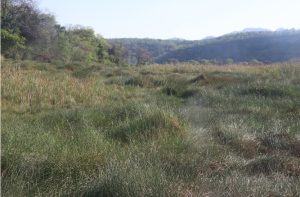
Kanyemba salt pan
DOWN RIVER TO KANYEMBA:
Unfortunately, I was not on the ball to get an article on this expedition and did not myself participate. I understand from the excitement that prevailed that it was highly successful and enjoyed by those who went. The rest of us awaited their return on tenterhooks hoping that we would beat the sun for our last sundowners together (we did)..
SUNDOWNERS: FROM BILL CLARKE

We “raise a glass” to Frances for organising the trip in all aspects, to the hunters and drivers.
and to Kanyemba (the ferocious one).

Mark Hyde

Cathy Sharp
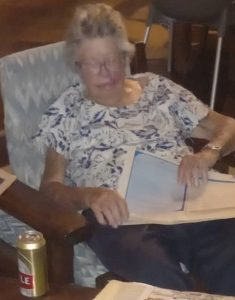
Meg Coates Palgrave

Relax and enjoy
The party continues but the serious botanists cannot be deterred from changing papers!
DAY 5: RETURN TRAVEL TO HARARE
MATOTA’S SHRINE: BY ROB JARVIS
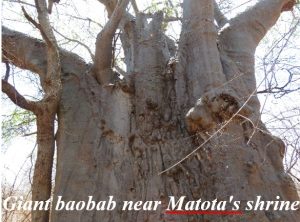
On the way back, my car with Sheila, Ryan Truscott and JohnLawrence as passengers and Zia’s with Vic and Lorraine, took the option to visit Matota’s shrine, where the hollow baobab was still very evident and all the indigenous trees still there, around and about. Grand specimens in every way and still protected by a battered national Museums and Monuments sign and, we were told, by the local people who revere the site and use it still for rain-making purposes.
The ruin appears to be a single circle, not very big and built on flat ground using the flat schist-like rocks to be found in the nearby escarpment. There was certainly nowhere for either Matota’s people nor his descendants to hide from a determined enemy as the National Monuments would have us believe. Matota himself apparently came to live at this place because he loved salt and he could get plenty from local salt pans, rather than burning goat dung, which was the preferred option around Zimbabwe Ruins.
FIFTY YEARS FROM ANGWA TO KANYEMBA: BY ROB JARVIS
Way back in 1974, I found myself at the Angwa Bridge, on the way up to Kanyemba in the far north of Zimbabwe. In those days there was a road and not much else. I was doing national service, with the Police and every couple of weeks we would be sent in a Land rover, two people to maintain law and order on the Zambezi Valley Floor. Our jurisdiction stretched from the fly gate at Mahuwe, at the base of the escarpment, to a small river about 10 kilometres beyond the Angwa Bridge. I remember the road beyond Sipolilo, now Guruve, as being very winding, and extremely well-treed as the top of the escarpment approached.
Down on the Valley floor cotton had not yet taken hold in the Zambezi Valley, that came post-independence in 1980. Tsetse fly ruled, there were few cattle and almost no cultivated land beyond a few plots along the rivers. Common practice in those days was for the locals to start planting in the rich annual alluvium washed down the Angwa in particular.
Once its waters receded, they would plant some maize beans and pumpkins in the thick red-brown mud left on the sand banks. Officialdom frowned upon such practices. Cultivation within 50 metres of a river is illegal in this country and remains so to this day. Luckily the reach of officialdom didn’t quite extend to the Valley floor in those days and events would overtake all other considerations as the war heated up. So the locals continued with their farming, quickly planting in February and reaping crops grown on residual moisture secured in the drying river bed.
In those days I wasn’t particularly interested in the trees, but I remember the road wending its way through magnificent miombo woodlands at the top of the escarpment and transitioning into vast forests, largely of cathedral mopane, interspersed with mixed dryland woodlands and as we found out on the Tree Society trip in early November this year that there were even patches of the typical tree spectrum found in the west of the country on the deep Kalahari sandveld.
Some fifteen years ago or so some bright spark in the political sphere decided that what the Angwa/Kanyemba district needed most of all was a huge irrigation scheme to grow cotton, wheat and other crops. Without thinking it through, some 2,500 hectares of land were clear-felled and cultivated, plans drawn up to extract water from the Zambezi and the project was all set to go. Luckily, International agreements on water usage precluded the arbitrary extraction of water from an international river, like the Zambezi unless all parties concurred, riparian and downstream. Agreement was never going to happen.
So now, on our trip, we witnessed the regrowth, shrubby, scrubby over thousands of hectares. It would make a great project for a budding botanist to do transects across the cleared areas and compare the species to be found with those in existing dryland woodlands still left intact. From what we could see, Mother Nature was winning the battle, cleared lands are now a mix of woody plants, grasses and herbaceous ones.
One further aside, a couple of years after I was stationed at Angwa Bridge in 1974/75 I returned in about 1977 for a six week call-up. We were deployed on the road down from Karoi on the edge of the Chewore wildlife area. The Valley floor in those days was literally crawling with rhino and we had hardly walked 100 metres when we stumbled across three black rhino slumbering in the scrub. That first night we slept on a small ridge and a cantankerous rhino entered our camp and had us all firmly treed in no time. All except one person, who shinned up the nearest tree, right to the very top. We called to each other to make sure all were safe and the reassuring sounds of others about 3 to 4 metres up substantial trees. His plaintive response came from below us and looking down we saw him hanging from a willowy sapling, upside down and barely a metre off the ground! The tree, which we never identified was a very poor choice.
The next night, it was in September and the days were bright and clear and we were camped next to a small streambed, very dry and innocent-looking. In the morning, after an uneventful night, we suddenly heard a loud crashing and thundering and the very ground was shaking under our feet. The donga was about fifty metres wide and ten deep and it filled immediately with brown frothy water, tumbling trees, driftwood and even boulders! There had been a cloudburst up above the escarpment and right over the source of our little river. Not a cloud in the sky where we were.
EDITOR’S NOTE: My apologies to Rob Jarvis who provided me with a fascinating contribution covering aspects of the whole trip plus some additional reminiscences. I have used the sections from this under the various days to which they principally relate and now present the rest of his fascinating insight into the area.
A FINAL WORD FROM MEG COATES PALGRAVE
I really enjoyed the chance to be part of this expedition with the intense interest in botany and the stimulating people to talk to.
EDITOR’S COMMENTS
If you have managed to read through this edition of Tree Life you will know what fun we had, what a fantastic learning experience this was and you don’t have to be a tree fundi to be part of the next long outing. We look forward to more such trips in 2024.
TREE SOCIETY COMMITTEE AND CONTACTS
Chairman Tony Alegria tonyalegria47@gmail.com 0772 438 697
Honorary Treasurer Bill Clarke wrc@mweb.co.zw 0772 252 720
Projects Jan van Bel jan_vanbel@yahoo.com 0772 440 287
Venue Organiser Ann Sinclair jimandannsincs@zol.co.zw 0772 433 125
Committee Member Ryan Truscott ryan.kerr.truscott@gmail.co 0772 354 144
Secretary Teig Howson teig.howson@gmail.com 0772 256 364
Tree Life Editor Linda Hyde Lmharwin@pentact.co.zw 0772 232 075
Tree Society Website https://treesociety.org.zw/
Tree Society Facebook https://www.facebook.com/groups/ztreesociety/
Flora of Zimbabwe: https://www.zimbabweflora.co.zw/
Flora of Tropical Africa: https://plants.jstor.org/collection/FLOTA



